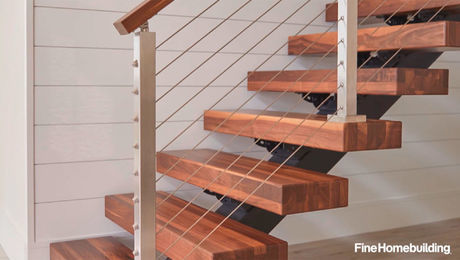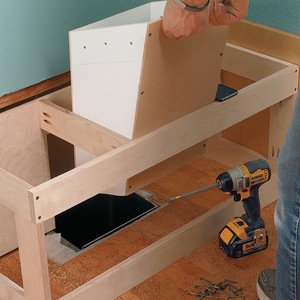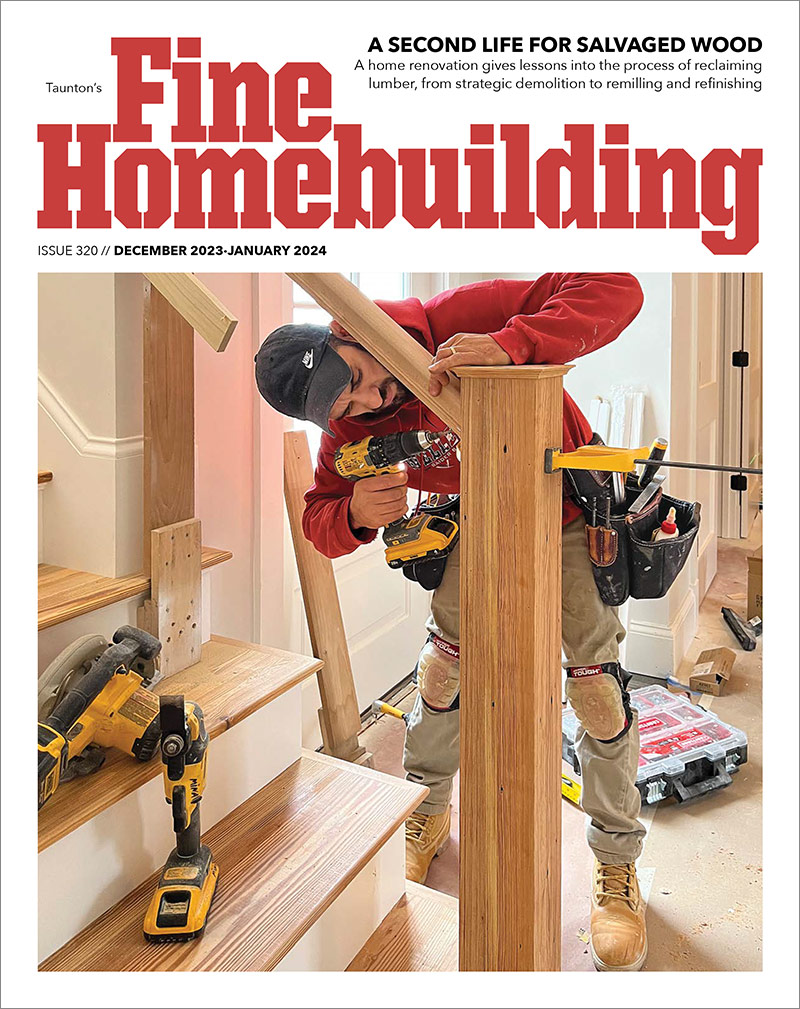I’m a fairly handy guy. My sweat joints don’t leak (usually). I can figure out wiring and do a neat job in a panel, and if I take my time and think about what I’m doing and why, I can frame or hang sheetrock and pretty much have it come out as if a specialist did it.
Having said that, I can’t for the life of me get predictable results cutting glass. Sometimes it’s a clean straight break and others it’s anything but.
Does anyone have a few pearls of wisdom for me so that the glass will break where I want it every time?


















Replies
Your cutter needs to be sharp. You need lube - turpentine or paint thinner on the cutting wheel and on the cleaned off cut line. Even pressure and one pass. Start the break from one end. Wear gloves and eye protection.
If you have gone over a cut line or failed to use lube with the cutter you have, that cutter is dead. Throw it out.
Store you glass cutter in something to protect the wheel and add a few drops of oil to it if you're not going to use it for a while.
1) Sharp cutter (wheel or diamond)
2) Clean glass
3) Kerosene lube
4) Constant pressure, not too hard or too soft
5) Gentle, but firm, snap, grasping each side of the cut line, thumbs up.
6) Cross yer fingers.
Mike Hennessy
Pittsburgh, PA
Let me add: don't try to cut old class. It always gives me a jagged edge if it cuts on/near the line at all. Fresh class cuts best.
I use denatured alcohol for the lube/cleaner. Spirits is fine too. Clean clothe wetted to wipe the glass first, then dip the cutter and make a firm clean pass.
Reason for the clean - the score on the surface has to be continuous. If there is a tiny bit of grit right in the cut line, the cutting wheel will skip over it and a non-continuous line will make the break uneven as the fracture wanders around trying to find itself.
Same thing with a nice sharp cutter. a dull flat spot leaves a skip in the cut line so the fracture has to jump from one cut to the next.
Welcome to the
Taunton University of Knowledge FHB Campus at Breaktime.
where ...
Excellence is its own reward!
Others here have already given you the basics.
The only other "trick" that I have is to accurately score both sides of the glass. I'll only do this when I'm trying to snap off a narrow little strip (like a 1/2" or something), or if I'm working with old glass. But in these circumstances, it has worked well for me.
My glass guy: Gene Loyd; Loyd's glass; Covington GA; swears by motor oil for lube. Won't guarantee cuts in old glass, but he can do it more often than I can.
Forrest
Yeah, I've always used motor oil or 3 in 1 or air tool oil or something of similar viscosity and while I'm certainly no pro, I've gotten excellent results.http://grantlogan.net/
Tap along the score line from the opposite side with the knob end of the cutter. The cutting wheel makes tiny checks (cracks) along the line of the cutter. By tapping the glass you make the checks grow and join together.
An additional note on tapping.
If you tap to get your line break, the edge will be more 'ragged' than a normal continuous break from one end.
Fine for windows or stained glass that will have the edge covered, but for shelves as in a curio cabinet or such, a tapped edge will be much more difficult to sand smooth and even. (been there, done that)
To re-emphasize what Link said, score the glass ONCE. Stained glass shops sell high quality cutters. I've seen kerosene used as lubricant most often, but anything that keeps that little wheel from binding will do the job. The ball on the other end of the cutter is to tap from the underside as mentioned. If you're trying to snap off narrow strips, a pair of glass pliers helps.
This is a good thread! I never knew about the tapping trick before
Welcome to the Taunton University of Knowledge FHB Campus at Breaktime. where ... Excellence is its own reward!
"I never knew about the tapping trick before"
That's why there's that little solid ball on the end of the cutter.
FWIW...........
For curves, arcs, and circles...one pass cut on the shapes line of cut. Or straights.
Turn the glass cut side down on a flat sturdy surface covered with one layer of cardboard. Place your thumb on the score and press until you see the glass split slightly, then using your thumb pressure "chase" that fracture line completely along the cut line.
For curved cuts from glass edge to edge this method should yiields two easy pieces.
For enclosed shapes, ovals, circles etc. allow 2" at all perimeter and cut/score several tangent lines to break and release the shape from the sheet after you "chase the score line as above.
Single & double strength is easy. 3/16" is tougher. 1/4" stuff usually gets sent to the professionals at the glass shop.
The other use for that little ball on the end of the cutter is when scoring straight score line on on glass cut on the table top, then carefully raise the glass up at the end of the cut line and place the ball directly under the cut and set it back down.
Gently press on the raised glass edge on both sides of the cut several inches away, or at the corners of the sheet and watch the glass shear from one sie to the other along the score.
...............Iron Helix
On 1/8" glass, tapping on the underside of the score line is usually not necessary if you are cutting off a fairly large piece (say 6-8" or more), but it is a crucial step for cutting off narrower strips.
For thicker glass (like 1/4" plate glass)it is useful to have something more substantial than the ball on the cutter to tap the underside of the score line.
I have one of these Warrington hammers (the 4 oz size), since the wedge shape can concentrate your blows on the cut line:
http://www.toolsforworkingwood.com/indextool.mvc?prodid=EE-615-WH1.XX
Also, there are fancy glass cutters available, but I have always used the cheap Red Devil brand. The key, however, is to replace them frequently -- say after 25-30 cuts. I learned this trick from a guy in a glass shop, where they start each day with a new cutter.
Finally, if you are cutting old glass, be sure to clean it first -- then proceed with the lubing others have mentioned. I like kerosene, but almost any lube will do.
********************************************************
"It is what we learn after we think we know it all, that counts."
John Wooden 1910-
in a glass shop, where they start each day with a new cutter.
That's an interesting point. I'm sure my cutter wheel is well past retirement!
<in a glass shop, where they start each day with a new cutter>
Read an interesting magazine article on one of the high-end wallpaper guys, who made EACH CUT with a new razor blade.
As expensive as some of the fine stuff is, it seems like cheap insurance.
Forrest - starting each reply with a blank screen
Read an interesting magazine article on one of the high-end wallpaper guys, who made EACH CUT with a new razor blade.
I was out at a job several years ago where a wallpaper guy was using blades like they were going out of style! I asked him about it and he pretty much said what you surmised -- cheap insurance.
when I work in a glass store, when we cut the one inch thick stuff, we scratch one time, put a pencil under each end, then climb on the table and jump on it.work every time
Using the pencils as a sort of "fulcrum" to concentrate the bending stresses where you want them sounds like a good idea.
I'm not so sure about the jumping on the table, part, though. ;)
No wonder my hangers charge so much...
Puuhlease........
Thanks everyone. Most of the tricks I've already heard of, but some are new to me.
Does anyone know if a diamond scribe is any better than the old standby wheel type cutter?
Great thread!
When scoring glass, what you are trying to do is drive micro-fissures straight down into the glass.
Pressing too hard on the cutter while scoring the glass or using a cutting wheel that has the wrong angle for the glass thickness will cause the fissures to angle away from the cut rather than driving straight into the glass along the length of the score line.
If you score glass and you have those little glass chips along the edge of the score line, then you are pressing too hard. The best glass score line (correct pressure on the cutter) will result in a barely visible scratch in the surface of the glass.
Too much pressure on the cutter, or the wrong angle on the cutting wheel, can result in a weaker cut edge and is more likely to "run" or to veer off the cut line ruining the cut.
Glass "heals" itself when cut. The primary reason for using a lubricant when scoring glass (and all of those mentioned in the thread will work) is because the liquid will penetrate into the fissures that result from scoring the glass and will prevent the fissures and the score from "healing" or closing.
Clean and dry glass ,use carbide cutter,turps (use an oil can) to flood along the cut line and a short 1/4"x 2" hardwood dowel
Lay sheetglass on a flat carpeted surface (Not Shag!)
Use a straight edge for straight cuts. Start at the far end and pull toward the near end in ONE pass.
Place dowel parallel and under the cutline at near end.
Press (with two thumbs) both sides down over each side of the fulcrum.
Curved glass: Lay a sheet of paper (with the curved outline drawn on it) under the glass. Cut forward, (so you can see the unobstructed line)
Don't stop until finished.
Tap the under side along the cut and gently snap the glass with gloved hands. Steinmetz.
Note! Don't try to cut tempered glass 'twon't work and will destroy the wheel.
Edited 6/18/2007 2:12 am ET by Steinmetz
Steinmetz,I have a question about something you said: "Note! Don't try to cut tempered glass 'twon't work and will destroy the wheel."I know it won't work, and why. But how does it destroy the wheel? What is the process by which the wheel is damaged?Just tonight I was cleaning putty off the glazing on a new door and the label had all these warnings about how easy it is to scratch tempered glass. I did not scratch it, but it made me wonder: Is the surface of tempered glass harder or softer than the same piece of glass in the annealed state? I really don't know, and the answer is not obvious from here.Any light you can shed on this will be deeply appreciated. Thanks.Bill
B B, I tried to cut tempered glass once. It was an 'exercise in futility'I managed to etch a groove by the third try but even jumping on the^&*($)#$ thang, it wouldn't yield.
Ruin't the carbide cutter to boot.Seven bux for a new one DRAT!Methinks, the tempered glass becomes sort of 'case hardened' and becomes
tensioned or, stressed when made. I know a simple knock or, nick by a sharp object will shatter the stuff into snow, Once, I carried a metal tool box into a bar. The corner of the box struck the Hurculite ™ glass door (3/4" thick) and the whole door exploded/imploded???
Luckily, a ball game was on the TV, and the crowd in the bar made so much noise , they never noticed my 'Boo Boo'
SteinmetzEdited 6/18/2007 11:13 am ET by Steinmetz
Edited 6/18/2007 11:15 am ET by Steinmetz
Whether or not the surface of tempered glass is "harder" (and I don't really know), a scratch in it is much more likely than with regular glass to result in a shatter. Regular glass has it's moecules somewhat random (at least for glass), and tempered stuff relies more on aligned molecules. That's why it shatters in short, blunt-ish bits rather than long, sharp shards, wich is more or less the point of the stuff.
I always use mineral spirits as lube, and assume that I've ruined the cut if it seems that more than one pass with the cutter is needed. I've saved some cuts by making ten passes, but never two. Exception to that is antique wavy glass. On that, I don't even try a wheel scribe, but lightly scratch each side repeatedly (like 30 times) with a dull knife and then clamp both sides between rags & softwood before cracking. Success rate is around 50 percent.
}}}}
Exception to that is antique wavy glass...
Are you trimming very small pieces?
I've cut a lot of that for old houses here. Rarely a problem with a standard wheel. I never fracture. Score, snap. Generally have at least 3/4" waste. Smaller is difficult.PAHS Designer/Builder- Bury it!
http://www.glassmart.com/toyo_oil_cutters.asp
About $18 retail, but we are seriouse glass cutters (stained glass and custom picture framing). Lubricant is oil in the handle, cutter is higher quality than you can get at a hardware store, and they last years if not abused.
Dave
The thing about making only one score is important. Also true for roller type tile cutters. Attempting to score the second time both destroys the cutter roller and makes for a jagged cut.
Of course, since you can only score once, it's important to get the first score right. Buy some panes to practice on before making the "real" cut. Make sure your work surface is solid and your straightedge is firmly secured before you start.
>>Make sure your work surface is solid and your straightedge is firmly secured before you start.
Don't forget flat. Trying to score and snap glass on a top that isn't flat is asking for a run out.
We use a double side tape (ATG) on a metal yard stick to secure it to the glass.
Dave